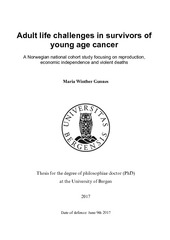| dc.contributor.author | Gunnes, Maria Winther | en_US |
| dc.date.accessioned | 2017-08-11T06:37:43Z | |
| dc.date.available | 2017-08-11T06:37:43Z | |
| dc.date.issued | 2017-06-09 | |
| dc.identifier.isbn | 978-82-308-3049-9 | en_US |
| dc.identifier.uri | https://hdl.handle.net/1956/16263 | |
| dc.description.abstract | Background: Cancer in childhood, adolescence and young adulthood now carries a survival rate of above 80%. This leads to an increasing proportion of young age cancer survivors in the adult population. These survivors are at risk of suffering from various late-effects after cancer treatment, which can impact their ability to participate in the society as self-sufficient, independent individuals, holding jobs and establishing families. Aims/objectives: We wanted to study male reproductive outcomes, economic independence and the risk of suicide or non-suicidal external deaths, in a national cohort of cancer survivors diagnosed before 25 years of age. Material and methods: Our study cohort consisted of all individuals born alive in Norway during the 20-year period from 1965 to 1985, as identified by the National Registry. By the unique personal identification numbers, we performed linkage with several national registries. The Cancer Registry of Norway, identified all individuals diagnosed with cancer before the age of 25 years. Further data was supplied by the Medical Birth Registry of Norway, the Norwegian Tax Administration, the Norwegian National Education Database, the Causes of Death Registry of Norway, and the Norwegian Labour and Welfare Administration. Our study population was followed prospectively over time, and data was analyzed using various regression models allowing for adjustments for confounders. Results: Cancer before the age of 25 was associated with a 28% reduction in paternity for male cancer survivors, and more than 3-fold increased risk use of assisted reproduction. The risk of adverse offspring outcomes was not increased. Furthermore, the paternity deficit was sustained when analyzing the married subcohort for most cancer diagnoses, except for survivors of central nervous system (CNS) tumors, suggesting a “social infertility” in this survivor group. We found the cancer survivors to have slightly less probabilities of marrying compared to the non-cancer references, although this was only significant when cancer was diagnosed during childhood (below age 15 years). In survivors of both sexes, there was an overall increased risk of receiving governmental financial assistance (27 % for men, 36 % for women) and of not being employed (42 % for men, 36 % for women). However, for those in paid employment, there were only slight differences in the representation in higher-skilled occupations. In general, slightly lower incomes were found for the cancer survivors. Income discrepancies were most pronounced for female survivors and for survivors of tumors of the CNS. For the analyses on suicide and non-suicidal external deaths, there was a 2.5-fold increased risk of suicide for the cancer survivors, both when diagnosed during childhood and as an adolescent/young adult. There was no increased risk for nonsuicidal external deaths. The suicides occurred at a median time of 12 years from cancer diagnosis, and only a small number occurred within the first year. The absolute number of suicides was low. Conclusions/implications: Our study identifies areas of struggle for cancer survivors diagnosed during childhood, adolescence and young adulthood. With an increasing survivor population, it is important to be aware of these challenges in order to secure optimal transfer of knowledge, development of guidelines, and ultimately securing adequate follow-up to the long-term survivors. Some of our findings need confirmation in further studies, whereas others confirm previous findings. | en_US |
| dc.language.iso | eng | eng |
| dc.publisher | The University of Bergen | eng |
| dc.relation.haspart | Paper I: Gunnes MW, Lie RT, Bjørge T, Ghaderi S, Ruud E, Syse A, Moster D. Reproduction and marriage among male survivors of cancer in childhood, adolescence and young adulthood: a national cohort study. British Journal of Cancer 2016; 114(3):348-56. The article is available at: <a href="http://hdl.handle.net/1956/12233" target="blank">http://hdl.handle.net/1956/12233</a> | en_US |
| dc.relation.haspart | Paper II: Gunnes MW, Lie RT, Bjørge T, Syse A, Ruud E, Wesenberg F, Moster D. Economic independence in survivors of cancer diagnosed at a young age: A Norwegian national cohort study. Cancer 2016;122(24):3873-3882. The article is available at: <a href="http://hdl.handle.net/1956/15764" target="blank">http://hdl.handle.net/1956/15764</a> | en_US |
| dc.relation.haspart | Paper III: Gunnes MW, Lie RT, Bjørge T, Ghaderi S, Syse A, Ruud E, Wesenberg F, Moster D. Suicide and violent deaths in survivors of cancer in childhood, adolescence and young adulthood- a national cohort study. Int J of cancer 2017;140(3):575-580. The article is available in the main thesis. The article is also available at: <a href="http://dx.doi.org/10.1002/ijc.30474" target="blank">http://dx.doi.org/10.1002/ijc.30474</a> | en_US |
| dc.title | Adult life challenges in survivors of young age cancer. A Norwegian national cohort study focusing on reproduction, economic independence and violent deaths | en_US |
| dc.type | Doctoral thesis | |
| dc.rights.holder | Copyright the Author. All rights reserved | |
| dc.identifier.cristin | 1472826 | |
